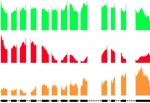RNA splicing allows the same gene to transcribe different RNA sequences. These different RNA transcripts are called alternative spliceforms.
We often want to know which of these spliceforms is present in our original RNA samples. This can be challenging, depending on how the reads align to the alternative spliceforms.
Example 1

In this example, we have a gene that makes two RNA molecules (Spliceform 1 and Spliceform 2). The thick parts of each spliceform are the exons, while the thin parts are the introns (these are the pieces of RNA removed during RNA splicing).
The read in this example aligns to an exon shared by both spliceforms. As a result, we can't tell which spliceform is in our original RNA sample.
Example 2

This read aligns to an exon that's only found in Spliceform 2. From this information, we can tell that Spliceform 2 was present in our original RNA sample.
Example 3

The most helpful type of read alignment for assessing alternative splicing is a spliced alignment. Remember, a spliced alignment comes from the part of an RNA molecule where two exons are joined. This means that a spliced alignment shows us exactly how the RNA molecule was spliced.
In this case, we can tell that Spliceform 1 was present in our original RNA sample.


 Discovering the Genome
Discovering the Genome